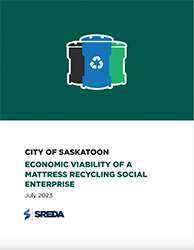Mattress Recycling

Mattresses and foundations (or box springs) are highly recyclable. The steel, foam, cotton, and wood that make up mattresses are successfully recycled every day in jurisdictions across North America. In Saskatoon this is not the case due to the distance to the closest mattress recycling facilities in Alberta and Manitoba.
As part of the ongoing implementation of the Solid Waste Reduction & Diversion Plan, the City of Saskatoon allocated funding in the 2024-2025 multi-year budget to work on the development of a mattress recycling program in Saskatoon with an emphasis on finding a local processor who can deliver additional social benefits to our community.
The next steps in this project are stakeholder engagement, an external funding assessment, and conducting a procurement process for mattress recycling.
Why do we need this?
It is estimated that 15,000 mattresses are disposed in the Saskatoon landfill annually. If those mattresses were diverted, 10,000 tonnes of regular garbage could be landfilled in their place. This is a much more efficient use of landfill air space which would extend the life of the landfill and increase revenue as customers pay based on weight.
What is the opportunity?
 In July 2023, SREDA completed a report on the Economic Viability of a Mattress Recycling Social Enterprise for the City of Saskatoon. The report concludes that this venture would address a significant environmental impact and bring about social benefits by creating employment opportunities and fostering community development.
In July 2023, SREDA completed a report on the Economic Viability of a Mattress Recycling Social Enterprise for the City of Saskatoon. The report concludes that this venture would address a significant environmental impact and bring about social benefits by creating employment opportunities and fostering community development.
What do other places do about mattresses?
Saskatchewan is the only province in western Canada without access to a recycling facility. Many facilities in our neighbouring provinces are operated by social enterprises focused on providing jobs and training to community members who face barriers to employment.
Individual mattress recycling facilities are unique and tailored to the communities they serve. For example, due to a relatively low population, the Penticton Area Cooperative Enterprises operates a mobile program that dismantles mattresses at landfill sites recycling metal and wood while disposing of other materials. In contrast, Mattress Recycling operates a permanent facility in the densely populated Metro Vancouver. In addition to these examples, city staff examined organizations in Winnipeg, Edmonton, and Port Alberni who use different operating models to provide unique services to their respective communities.
Provincially, British Columbia is the only jurisdiction actively developing a mattress extended producer responsibility program and expect to have it in place in 2025 or 2026. This will make mattress recycling mandatory across the province, reducing illegal dumping and improving the efficient use of landfills.
What is a mattress made of?
Mattresses and foundations are commonly made of steel, wood, foam and fabric. The recyclability of each of these components is highly dependent on local market conditions. The Mattress Recycling Council provides more information on the composition of mattresses and recycling options.
